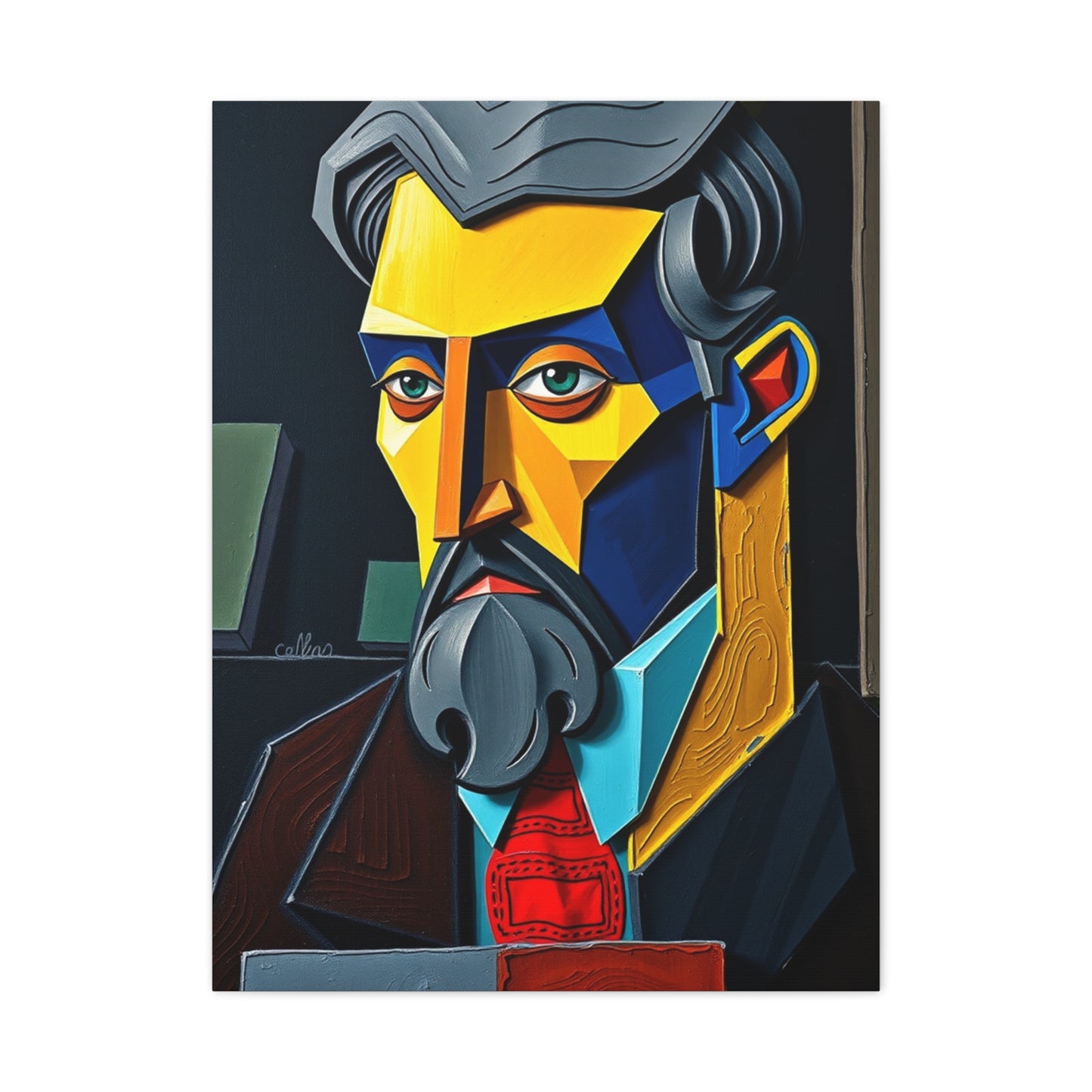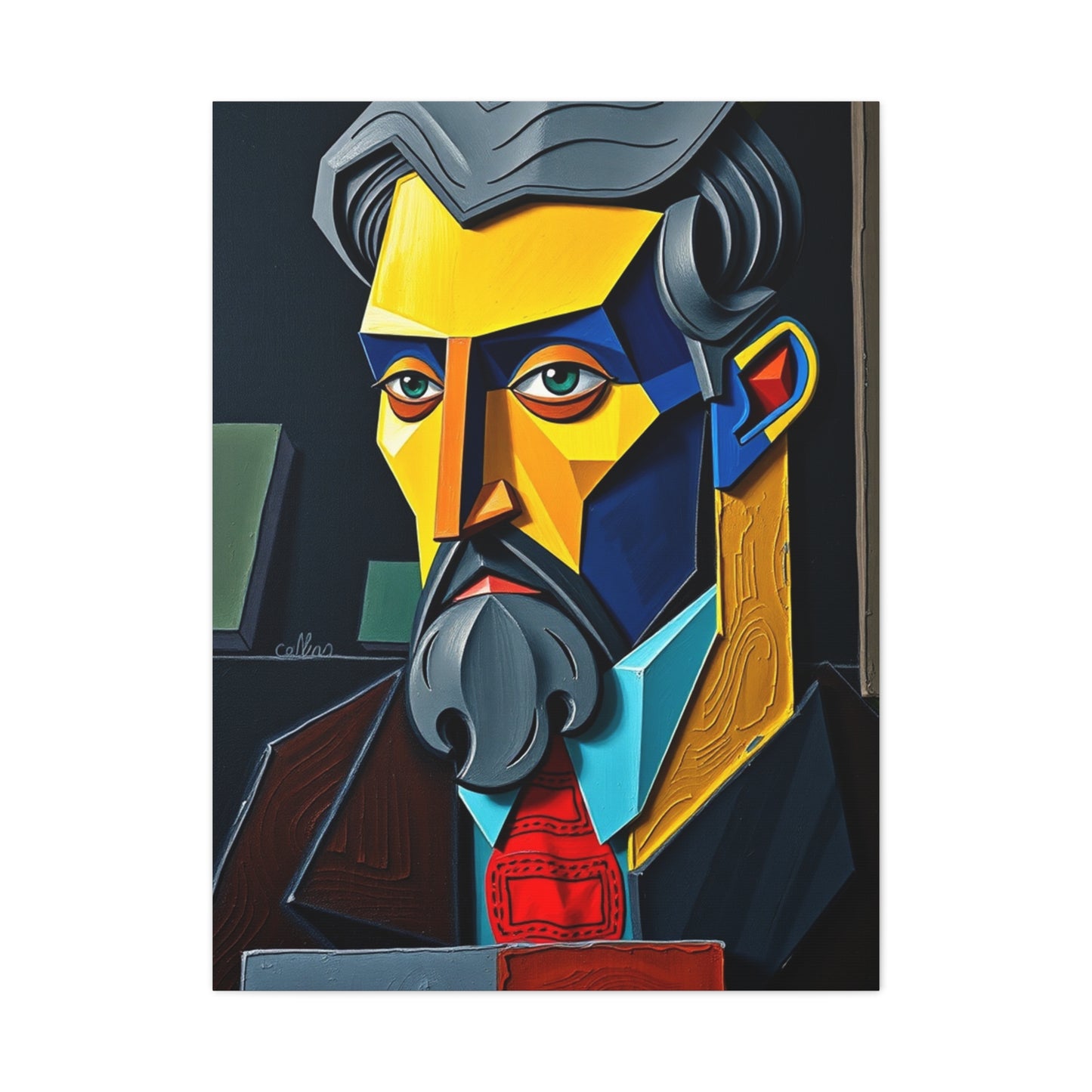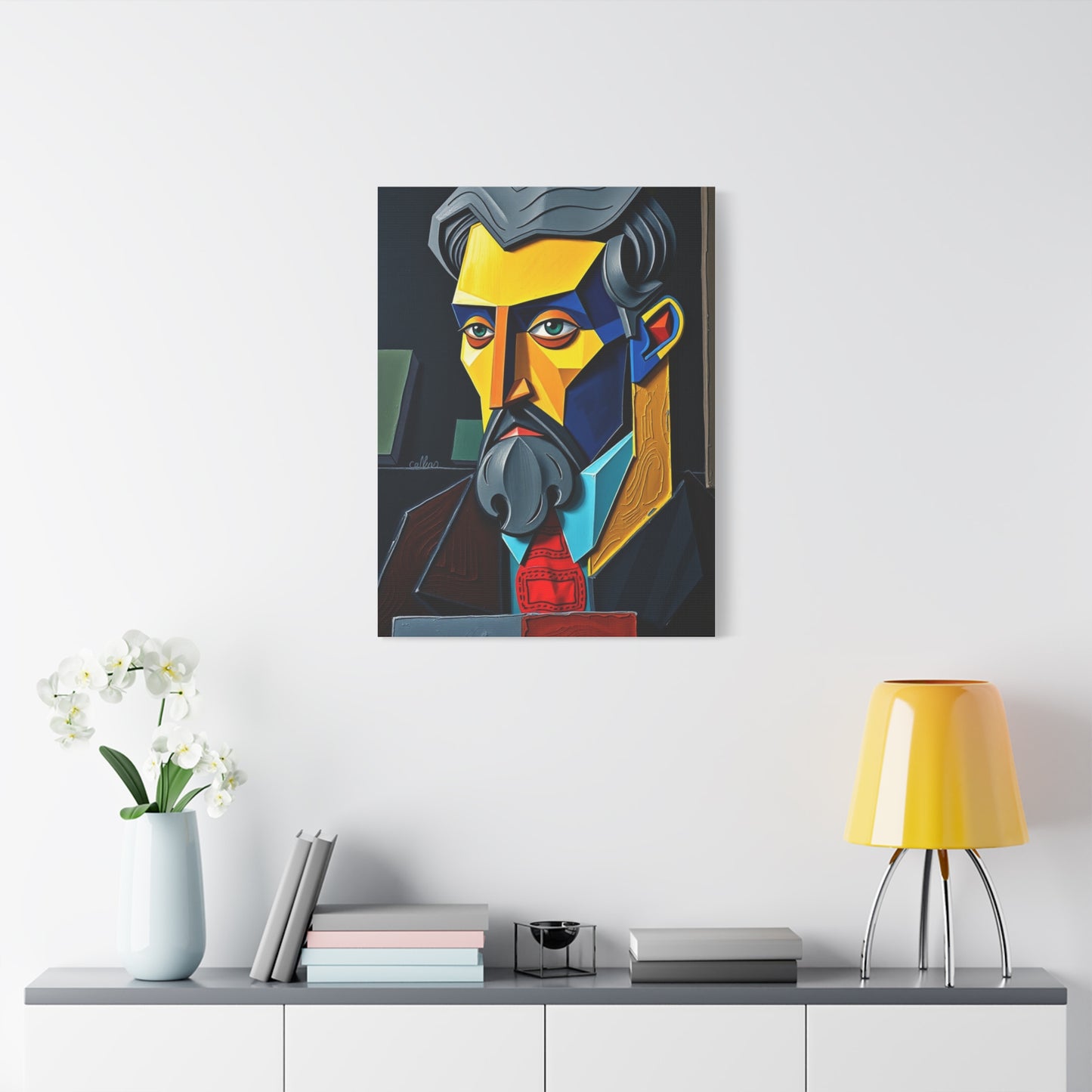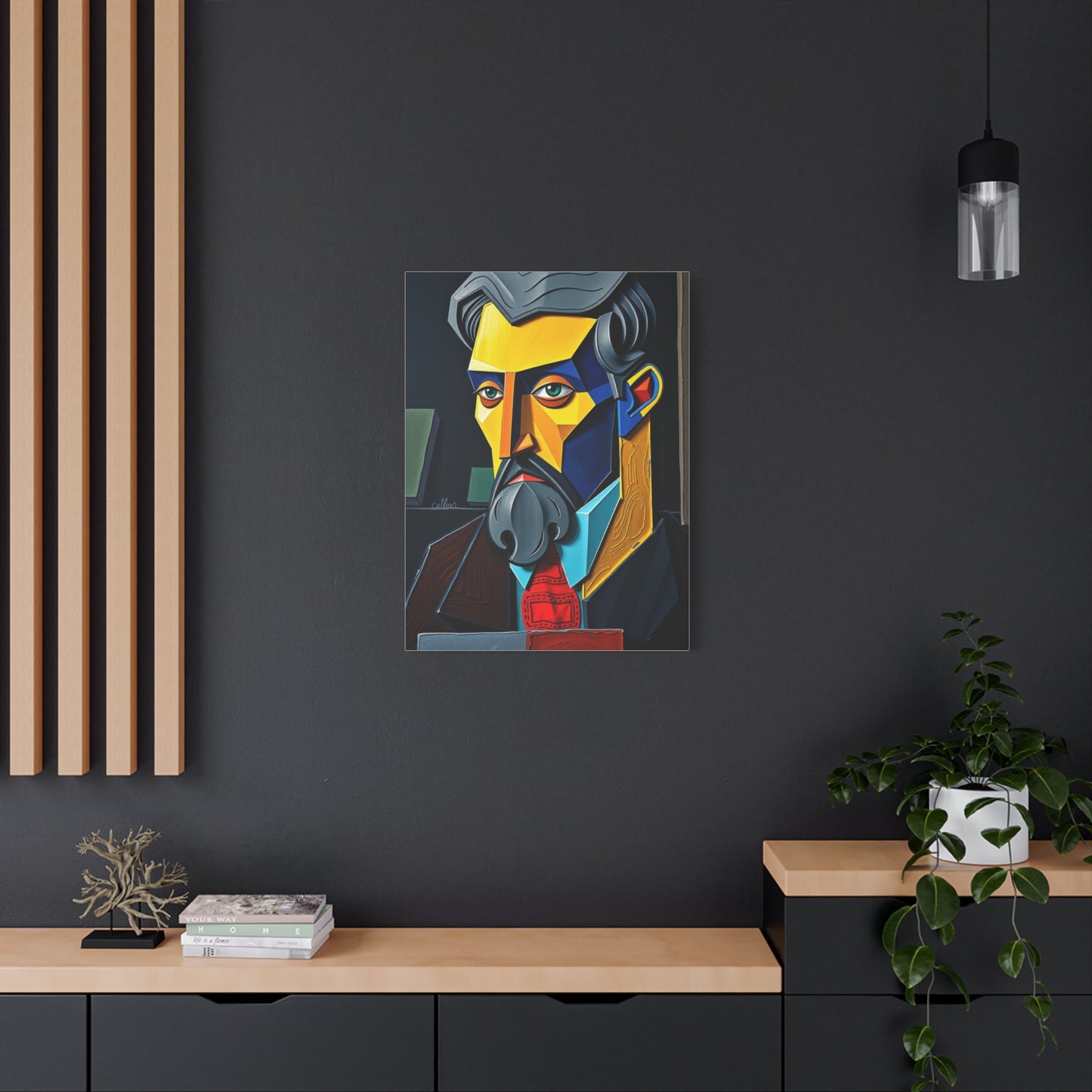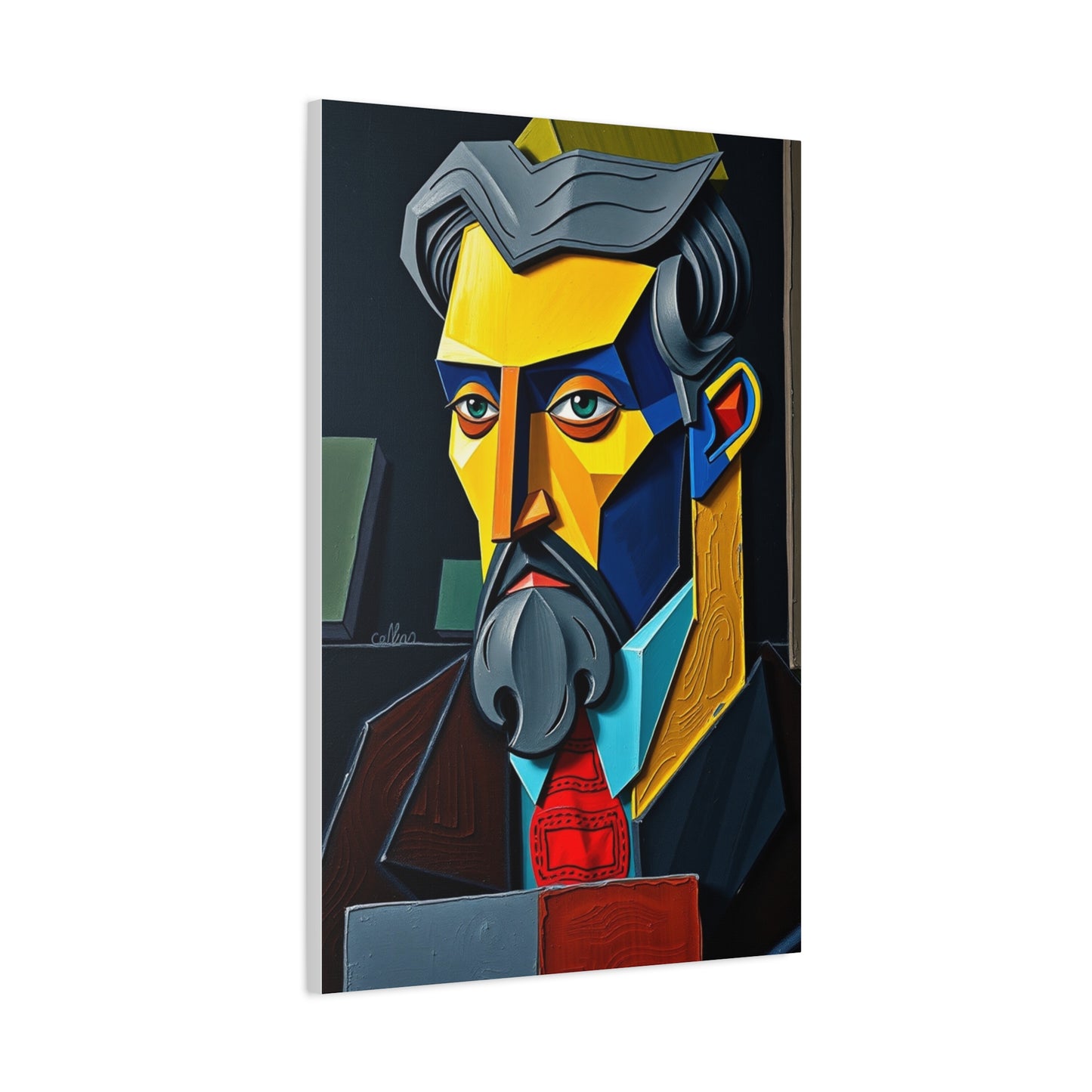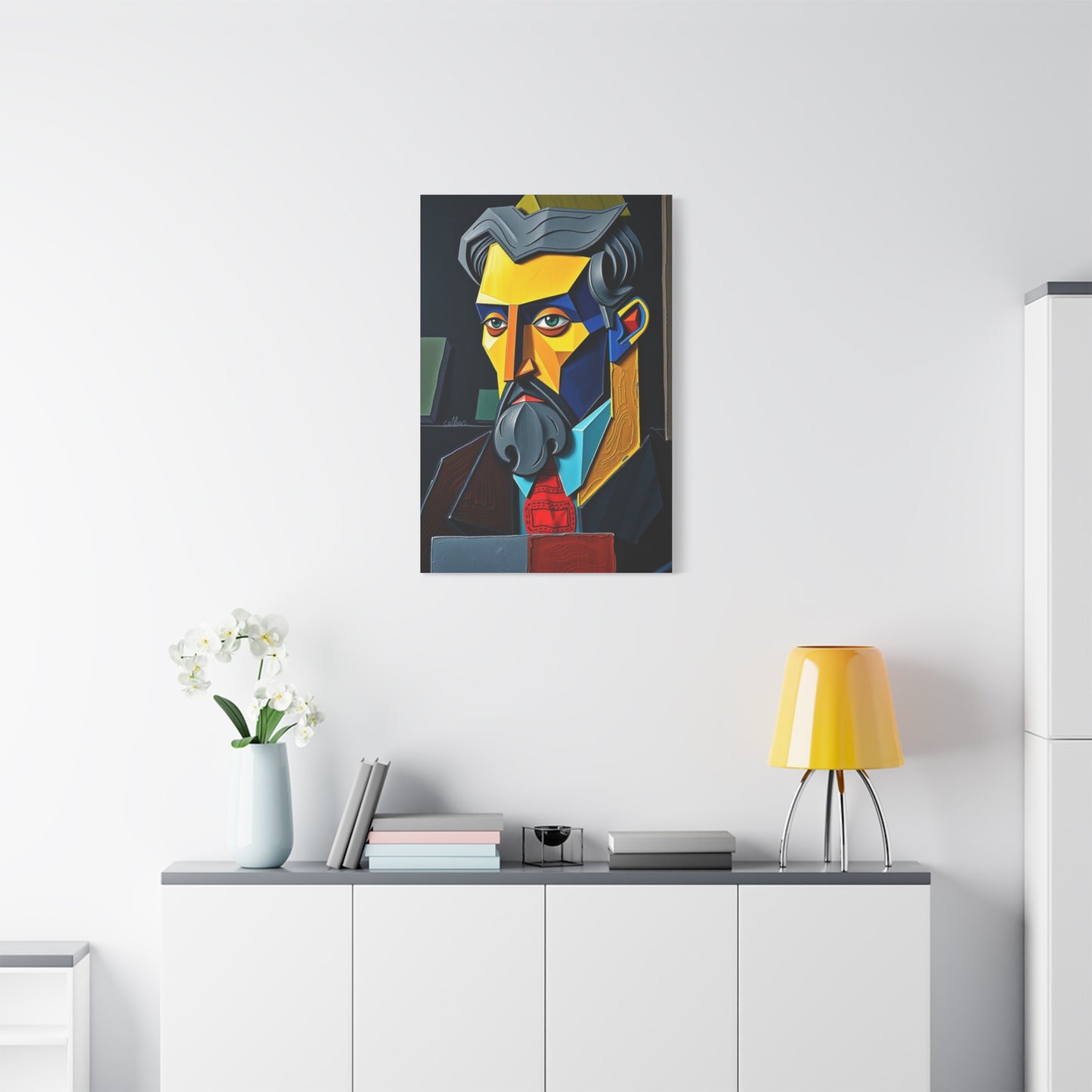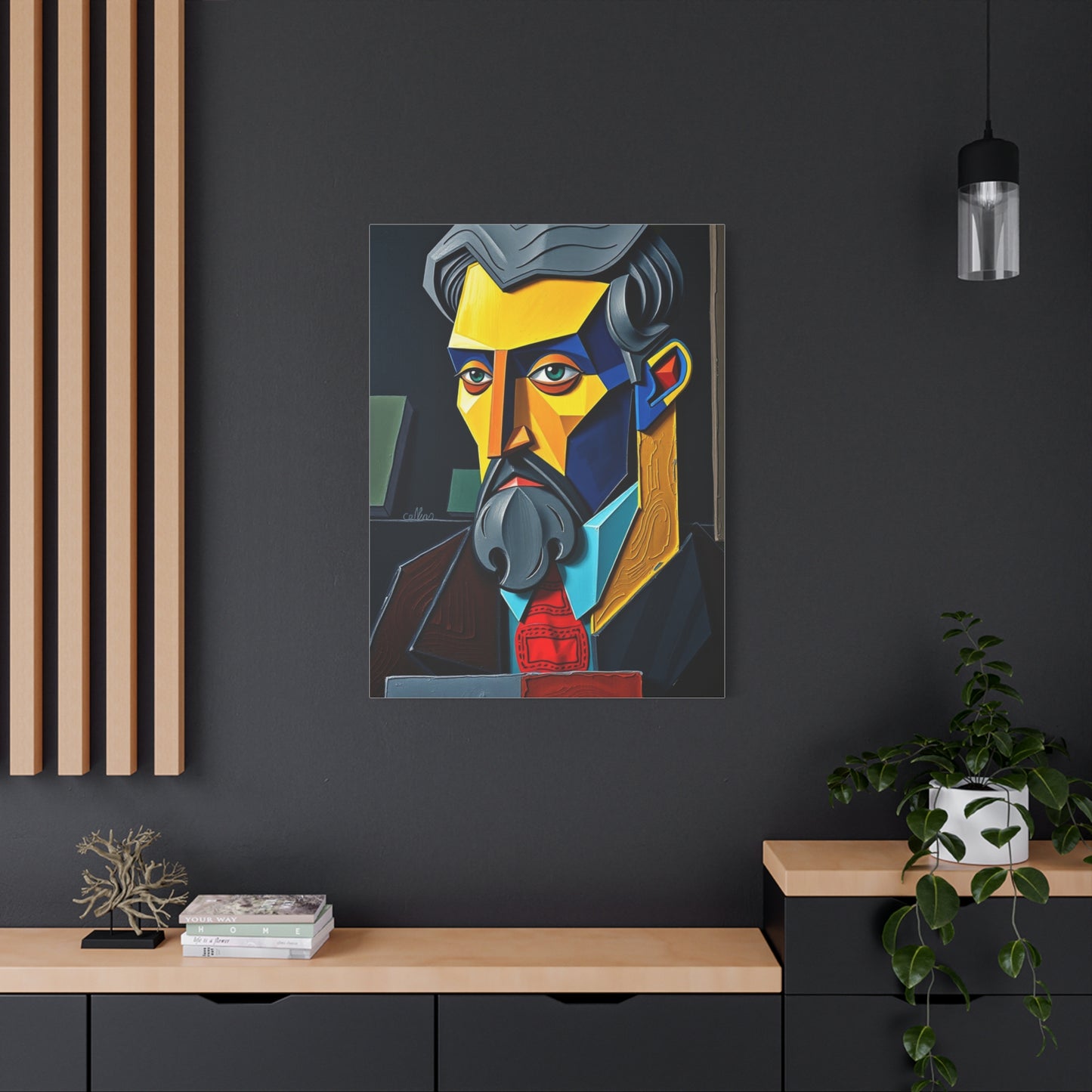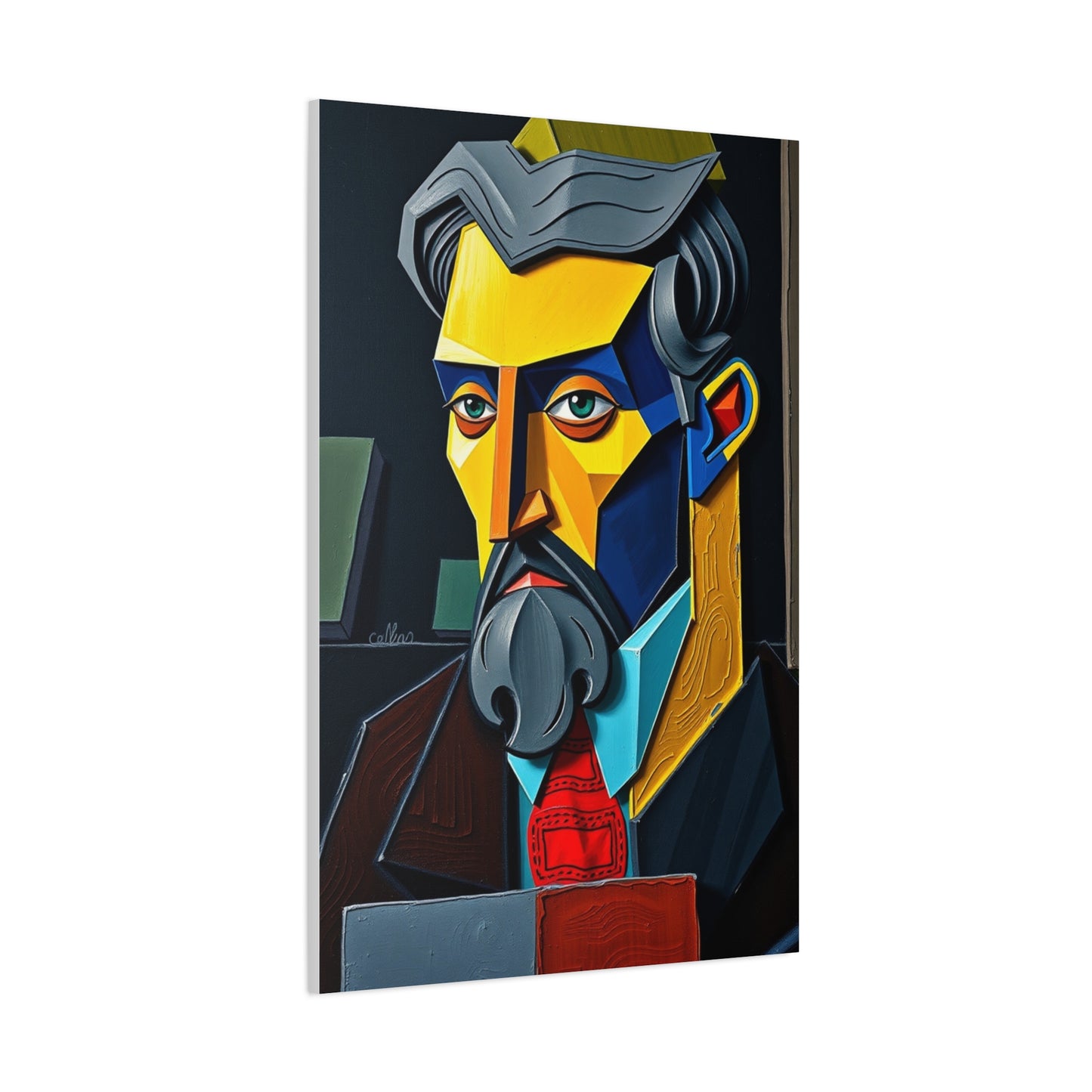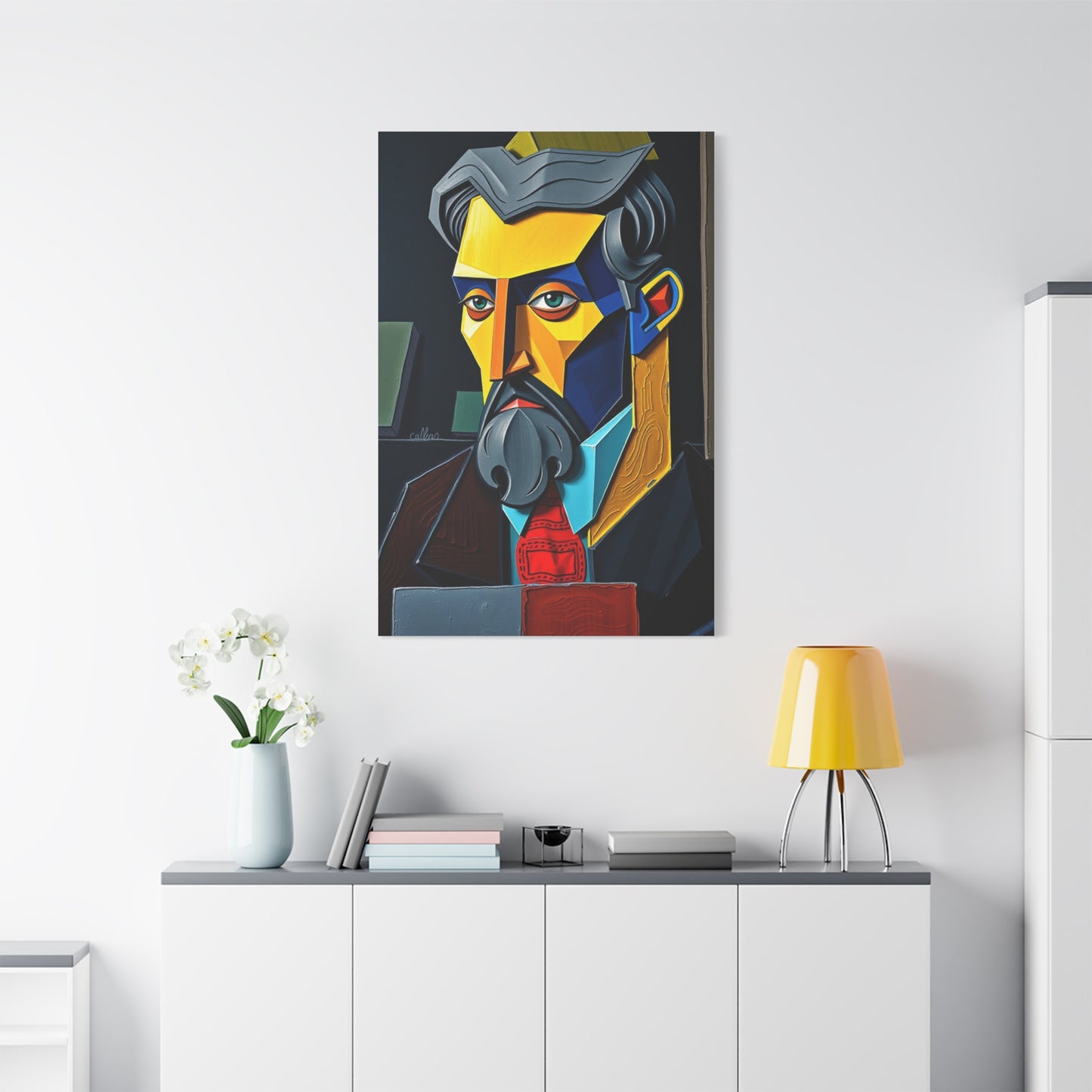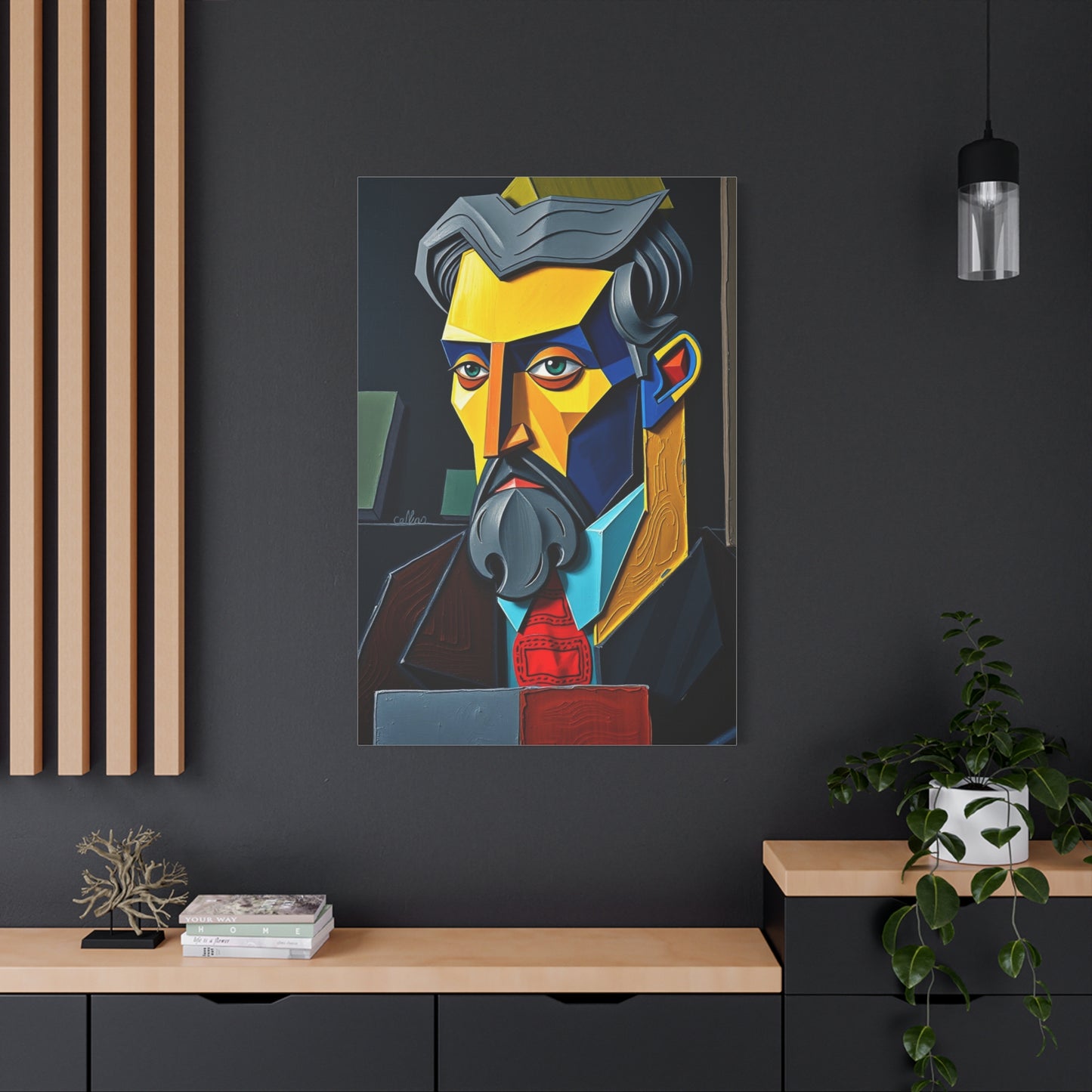Abstract Balance: Discover the Power of Cubist Aesthetic Wall Art in Modern Homes
The world of interior design constantly evolves, bringing fresh perspectives on how we perceive and interact with our living environments. Among the most captivating trends reshaping contemporary home aesthetics is the incorporation of fragmented geometric canvas wall art that draws inspiration from early twentieth-century artistic movements. This revolutionary approach to wall decoration combines sharp angles, overlapping planes, and multidimensional perspectives to create visually striking focal points that transform ordinary rooms into extraordinary spaces.
The appeal of angular abstract artwork lies in its ability to challenge traditional perceptions of space and form. Unlike conventional decorative pieces that simply fill empty wall space, these geometrically inspired creations engage viewers on multiple levels, encouraging them to explore different interpretations and discover new details with each viewing. The interplay of shapes, colors, and perspectives creates a dynamic visual experience that brings energy and sophistication to any room.
Modern homeowners and interior designers increasingly recognize the transformative power of geometrically fragmented wall art. These pieces serve as more than mere decoration; they function as conversation starters, mood enhancers, and architectural elements that define the character of a space. Whether adorning a minimalist apartment, a contemporary office, or a traditional home seeking modern accents, angular abstract canvas art bridges the gap between classical artistic principles and contemporary design sensibilities.
Understanding the Historical Foundations of Fragmented Geometric Art
The roots of angular abstract wall art trace back to revolutionary artistic movements that emerged during the early twentieth century in Europe. Pioneering artists challenged conventional representation by deconstructing subjects into geometric forms, presenting multiple viewpoints simultaneously on a single canvas. This radical departure from traditional artistic methods forever changed how we understand and create visual art.
The movement began as a response to rapidly changing societies experiencing technological advancement and cultural transformation. Artists sought new visual languages to express the complexity and fragmentation of modern life. By breaking down objects and figures into basic geometric shapes and reassembling them in abstract compositions, they created artworks that reflected the dynamic, multifaceted nature of contemporary experience.
These early innovators experimented with perspective, showing objects from multiple angles simultaneously. This approach revolutionized spatial representation, allowing viewers to see different sides of a subject within the same composition. The technique created visual puzzles that engaged viewers intellectually while delivering aesthetic pleasure through carefully balanced arrangements of form and color.
The analytical phase of this movement focused on subdued color palettes dominated by browns, grays, and ochres, emphasizing form and structure over chromatic expression. Artists meticulously dissected subjects into overlapping geometric planes, creating complex networks of angular shapes that challenged viewers to identify the underlying subject matter. This cerebral approach demanded active participation from audiences, transforming passive observation into active interpretation.
As the movement evolved, practitioners introduced more vibrant colors and decorative elements, creating works that maintained geometric fragmentation while becoming more visually accessible. This synthetic phase incorporated collage elements, textured surfaces, and brighter hues, expanding the movement's expressive possibilities while retaining its fundamental commitment to geometric abstraction and multiple perspectives.
The influence of these pioneering artists extended far beyond their immediate circle, inspiring subsequent generations of creators across various disciplines. Architecture, graphic design, fashion, and industrial design all absorbed lessons from geometric fragmentation, incorporating angular forms, overlapping planes, and dynamic compositions into their respective fields. Today, these principles continue to shape contemporary visual culture, including the design of modern canvas wall art.
Selecting the Perfect Angular Abstract Canvas for Your Space
Choosing appropriate geometric fragmented artwork requires thoughtful consideration of multiple factors including room size, existing decor, color schemes, and intended atmosphere. Understanding how different characteristics of angular abstract pieces interact with spatial environments helps ensure selections enhance rather than overwhelm living spaces.
Room dimensions significantly influence optimal artwork size and scale. Large open spaces with high ceilings accommodate substantial statement pieces that would overpower smaller rooms. These dramatic works fill vertical space effectively while creating impressive focal points visible from various positions throughout the room. Conversely, compact spaces benefit from smaller pieces or carefully arranged groupings that provide visual interest without dominating limited wall space.
Existing color palettes within rooms guide appropriate artwork selections. Complementary color schemes, where artwork incorporates hues opposite existing colors on the color wheel, create vibrant contrasts that energize spaces. Analogous schemes featuring colors adjacent on the color wheel produce harmonious, cohesive environments. Monochromatic approaches using various shades of single colors create sophisticated, unified atmospheres with subtle visual interest.
The style and period of existing furniture influences compatible artwork choices. Mid-century modern furnishings pair naturally with angular abstract pieces, sharing similar aesthetic foundations in geometric forms and clean lines. Contemporary minimalist spaces benefit from geometric art that maintains visual interest while respecting the overall simplicity. Traditional interiors can successfully incorporate angular abstract works as unexpected contrasts that modernize classic environments without completely abandoning their historical character.
Lighting conditions dramatically affect how angular abstract artwork appears and functions within spaces. Natural daylight reveals subtle color variations and creates changing shadows that animate geometric forms throughout the day. Artificial lighting requires careful planning to ensure adequate illumination that showcases artwork effectively. Directional spotlights can create dramatic effects by emphasizing specific elements while casting intriguing shadows. Ambient lighting provides even illumination that allows overall compositions to shine without creating harsh contrasts.
The intended purpose and atmosphere of each room should guide artwork selection. Bedrooms typically benefit from calmer compositions with soothing color palettes that promote relaxation and restful sleep. Living rooms accommodate bolder pieces that stimulate conversation and create welcoming environments for social gatherings. Dining areas pair well with artwork that maintains visual interest without overwhelming the sensory experience of shared meals. Home offices and creative spaces thrive with dynamic compositions that inspire productivity and innovative thinking.
Personal emotional responses to specific pieces should ultimately guide final selections. Beyond technical considerations of size, color, and style compatibility, artwork must resonate on an individual level to successfully enhance living environments. Trust instinctive reactions when viewing potential pieces, as genuine emotional connections ensure lasting satisfaction with decorative choices.
Color Theory Applications in Geometric Abstract Wall Art
Understanding color relationships and interactions proves essential when selecting or creating angular geometric canvas pieces. Color theory provides frameworks for combining hues effectively, creating visual harmony, and achieving specific emotional or aesthetic effects. Applied to fragmented geometric art, these principles help designers and homeowners make informed decisions that maximize artistic impact.
Primary colors red, blue, and yellow form the foundation of traditional color theory. These hues cannot be created by mixing other colors, making them fundamental building blocks for all other shades. In angular abstract compositions, primary colors deliver bold, straightforward visual statements that project confidence and energy. Their clarity and intensity make them particularly effective in modern, minimalist environments where direct, uncomplicated aesthetics prevail.
Secondary colors orange, green, and purple result from mixing equal parts of two primary colors. These hues offer slightly more complexity than primaries while maintaining strong visual presence. Geometric artwork incorporating secondary colors often feels more nuanced and sophisticated than pieces relying exclusively on primary hues, providing visual interest without overwhelming intensity.
Tertiary colors emerge from mixing primary and secondary colors, creating shades like red-orange, blue-green, and yellow-green. These intermediate hues provide subtle transitions between more dominant colors, allowing artists to create sophisticated gradations and complex color relationships within angular abstract compositions. Tertiary colors add depth and refinement, elevating simple geometric arrangements into visually rich experiences.
Complementary color schemes pair hues opposite each other on the color wheel, such as red and green, blue and orange, or yellow and purple. These high-contrast combinations create vibrant, energetic effects that naturally draw viewer attention. In geometric fragmented art, complementary schemes generate dynamic visual tension, with each color intensifying the other's impact. This approach works exceptionally well for statement pieces intended to dominate their environments.
Analogous color schemes employ three colors adjacent on the color wheel, such as blue, blue-green, and green. These harmonious combinations create cohesive, serene compositions that feel naturally unified. Angular abstract pieces using analogous schemes typically project calm sophistication, making them ideal for spaces designed for relaxation or contemplation. The subtle color variations maintain visual interest while promoting overall harmony.
Triadic color schemes use three colors evenly spaced around the color wheel, such as red, yellow, and blue, or orange, green, and purple. These balanced combinations offer vibrant diversity while maintaining visual equilibrium. Geometric artwork employing triadic schemes achieves dynamic energy without the extreme contrast of complementary pairings, providing versatility for various interior environments.
Monochromatic color schemes utilize various shades, tints, and tones of a single hue. This approach creates sophisticated, unified compositions with subtle depth derived from value variations rather than chromatic diversity. Angular abstract pieces in monochromatic palettes project elegance and restraint, working seamlessly with minimalist design philosophies while providing enough visual complexity to sustain interest.
Composition Techniques in Angular Geometric Canvas Art
Effective composition separates mediocre angular abstract artwork from truly compelling pieces. Understanding compositional principles allows artists to create balanced, engaging works while enabling collectors to recognize quality pieces worthy of display in their homes. These fundamental techniques govern how elements interact within the canvas, creating cohesive visual experiences.
The rule of thirds divides compositions into nine equal sections using two horizontal and two vertical lines. Placing key elements along these lines or at their intersections creates naturally balanced, visually pleasing arrangements. In geometric fragmented art, positioning dominant shapes, color masses, or focal points according to this principle produces compositions that feel intuitively correct, even when depicting abstract subjects.
Visual weight distribution ensures compositions feel balanced without necessarily being symmetrical. Larger shapes, darker colors, and more complex areas naturally attract greater attention, possessing more visual weight than smaller, lighter, or simpler elements. Successful angular abstract pieces distribute visual weight strategically, creating equilibrium that feels stable while maintaining dynamic interest. This might involve balancing a large dark shape on one side with multiple smaller bright elements on the other.
Focal points direct viewer attention to specific areas within compositions. While some abstract works deliberately avoid clear focal points, encouraging viewers to explore entire surfaces equally, others establish hierarchy through strategic placement of dominant elements. In geometric fragmented pieces, focal points might emerge through color contrasts, unique shapes, or areas of particular complexity that naturally draw the eye.
Movement guides viewers' eyes through compositions, creating visual journeys that explore relationships between elements. Angular abstract art establishes movement through directional lines, overlapping planes, and progressive color relationships. Effective movement keeps viewers engaged, leading them through compositions in ways that reveal the full complexity and beauty of geometric arrangements.
Rhythm in angular abstract compositions emerges through repetition of shapes, colors, or spatial intervals. Regular rhythm creates patterns with predictable repetition, generating feelings of order and harmony. Progressive rhythm involves gradual changes in repeated elements, such as increasingly smaller shapes or progressively lighter values, creating movement and development within compositions. Random rhythm employs varied repetition without obvious patterns, producing energetic, spontaneous effects.
Unity ensures all compositional elements work together cohesively, creating single unified works rather than collections of unrelated components. In geometric fragmented art, unity might be achieved through consistent color palettes, repeated shape families, or uniform treatment of edges and surfaces. Even highly complex angular compositions benefit from underlying unity that ties diverse elements together.
Variety provides visual interest by introducing differences within unified compositions. Complete uniformity produces monotonous results, while excessive variety creates chaos. Successful angular abstract pieces balance unity and variety, maintaining overall coherence while offering enough diversity to sustain viewer engagement. This might involve using consistent color families with varied values, or repeating geometric shapes in different sizes and orientations.
Materials and Canvas Types for Geometric Abstract Artwork
The physical materials and construction methods used to create angular geometric canvas art significantly impact final results, affecting everything from color vibrancy to longevity. Understanding various options helps both artists selecting materials and collectors evaluating potential purchases make informed decisions that ensure satisfaction and lasting value.
Canvas fabric types provide the foundation for painted geometric artwork. Cotton canvas offers affordability, wide availability, and good paint acceptance, making it popular for both student work and professional pieces. Its natural texture contributes character to finished paintings while providing adequate durability for properly cared-for artwork. Cotton canvas accepts gesso preparation well, creating smooth or textured surfaces according to application techniques.
Linen canvas represents premium choice for serious artwork, offering superior longevity, stability, and refined texture compared to cotton alternatives. The natural irregularities in linen weave create subtle surface character that enhances finished pieces. Linen's inherent strength and resistance to stretching ensure geometric compositions maintain their intended proportions over time. While significantly more expensive than cotton, linen's superior qualities justify the investment for important works.
Synthetic canvas materials, particularly polyester blends, provide modern alternatives to traditional natural fibers. These materials resist moisture, mildew, and environmental degradation better than cotton or linen, making them suitable for challenging display environments. Synthetic canvases maintain dimensional stability exceptionally well, though some artists feel they lack the character and traditional appeal of natural fibers.
Canvas texture, measured in weave density, affects how finished artwork appears. Fine weaves with tight, densely packed threads create smooth surfaces ideal for detailed geometric work where crisp edges and precise forms are essential. Medium weaves offer versatile surfaces suitable for most angular abstract pieces, providing slight texture without overwhelming geometric elements. Coarse weaves contribute pronounced texture that adds physical dimension to artwork, though they can make achieving sharp geometric edges more challenging.
Pre-stretched canvases mounted on wooden frames offer convenience and immediate usability. Gallery-wrapped styles where canvas extends around frame edges eliminate the need for additional framing, creating contemporary presentations suitable for modern interiors. Traditional stretched canvases with canvas only on the front face require framing but offer flexibility in presentation options and easier storage or shipping before framing.
Canvas panels, featuring canvas fabric mounted on rigid supports, provide stable alternatives to stretched canvas. These panels eliminate concerns about canvas sagging or warping while offering firm surfaces particularly suitable for geometric work requiring precise applications. Their rigid nature makes them easier to store and ship, though they typically require framing for finished presentation.
Print canvas specifically manufactured for digital reproduction differs from painting canvas in texture and coating. High-quality print canvas features consistent surfaces that accept ink evenly, producing accurate color reproduction and sharp details essential for geometric designs. Various coatings affect finish qualities, from matte surfaces that minimize glare to glossy finishes that maximize color saturation and depth.
Paint types dramatically influence how geometric abstract artwork appears and performs. Acrylic paints offer versatility, quick drying times, and water cleanup, making them popular for contemporary geometric work. Their rapid drying allows artists to build layers quickly, important when creating complex overlapping planes characteristic of angular abstract styles. Acrylics maintain color vibrancy well while resisting cracking and yellowing over time.
Oil paints provide traditional medium favored by many artists for their rich colors, smooth blending capabilities, and extended working times. The slow drying of oils allows subtle color transitions and corrections, though it also extends production timelines. Oil paintings develop characteristic depth and luminosity as they age, qualities many collectors prize. However, oils require ventilation during application and longer curing times before artwork can be safely handled or shipped.
Displaying Angular Geometric Canvas Art Effectively
Proper display techniques maximize the impact of geometric abstract artwork while protecting valuable pieces from damage. Understanding practical considerations regarding placement, lighting, and installation helps homeowners showcase their angular abstract collections to best advantage while ensuring long-term preservation.
Wall selection significantly influences how geometric artwork functions within rooms. Primary focal walls, typically the first wall visible when entering a room or the wall behind major furniture pieces, provide natural locations for statement pieces. These prominent positions ensure artwork receives appropriate attention while anchoring room design. Secondary walls offer opportunities for complementary pieces that support overall design schemes without competing with primary focal points.
Height placement affects viewing comfort and aesthetic impact. The standard guideline positions artwork centers at average eye level, typically between fifty-seven and sixty inches from the floor. This height ensures comfortable viewing for most people in typical circumstances. However, context matters; artwork viewed primarily while seated, such as pieces above sofas or in dining rooms, might hang slightly lower. Conversely, pieces in spaces with high ceilings or viewed from distances might hang higher than standard recommendations suggest.
Spacing considerations govern arrangements of multiple geometric abstract pieces. When hanging several canvases together, maintaining consistent intervals between frames creates visual unity and professional appearance. Two to four inches between frames generally works well for related pieces forming unified installations. Larger gaps suit pieces intended as separate entities rather than unified groups.
Gallery wall arrangements showcase collections of angular geometric pieces together, creating dynamic visual displays greater than the sum of individual works. Successful gallery walls balance various sizes while maintaining overall cohesion through consistent themes, color palettes, or framing choices. Planning arrangements on paper or using templates before installing artwork helps achieve desired results without unnecessary wall damage from repositioning.
Lighting dramatically affects how geometric abstract artwork appears and functions within spaces. Natural daylight provides ideal viewing conditions, revealing true colors and subtle details. However, direct sunlight causes fading and material degradation, requiring protective measures like UV-filtering glass or window treatments. Positioning artwork away from direct sun exposure while maintaining adequate natural light creates optimal conditions.
Artificial lighting requires careful planning to showcase angular geometric pieces effectively. Track lighting offers flexibility, allowing adjustments to direct light precisely where needed. Picture lights mounted directly above artwork provide focused illumination, though they work best with traditionally framed pieces rather than gallery-wrapped canvases. Recessed spotlights create dramatic effects through directional lighting that can emphasize geometric forms through strategic shadows.
Lighting angle influences how artwork appears and how viewers experience it. Light striking artwork at approximately thirty-degree angles minimizes glare while providing even illumination. Avoid positioning lights directly opposite viewing positions, as this creates reflections that obscure artwork. Multiple light sources often work better than single powerful lights, providing more even coverage without harsh shadows.
Frame selection, when used, significantly impacts how angular geometric artwork integrates with interiors. Simple, clean-lined frames complement angular abstract pieces without competing with geometric compositions. Metal frames project contemporary sophistication suited to modern geometric work. Wood frames offer warmth and traditional appeal, available in various finishes to coordinate with different interior styles. Floating frames create contemporary presentations that emphasize canvas edges while providing shadow gaps between artwork and frames.
Frameless gallery-wrapped presentations suit much contemporary geometric abstract art, eliminating barriers between artwork and viewers while creating clean, modern aesthetics. Ensuring canvas edges are properly finished becomes crucial with this approach, as sides remain visible. Painted edges, whether solid colors or extensions of front compositions, create polished appearances appropriate for quality pieces.
Color Palette Options for Angular Abstract Interior Design
Strategic color palette selection in geometric fragmented artwork determines how pieces interact with existing interiors and influence overall atmospheric qualities. Understanding various palette approaches helps homeowners and designers choose or commission angular abstract pieces that achieve desired effects while maintaining visual harmony with surrounding environments.
Neutral palettes featuring blacks, whites, grays, and earth tones project timeless sophistication that transcends temporary trends. These restrained color schemes allow geometric forms and compositional structures to dominate, emphasizing angular relationships and spatial dynamics over chromatic excitement. Neutral geometric artwork integrates seamlessly with virtually any existing color scheme, providing flexibility for evolving interior design preferences without requiring artwork changes.
Monochromatic palettes exploring various values of single hues create subtle, refined compositions with inherent unity. These sophisticated approaches suit minimalist interiors and contemporary spaces valuing restraint and elegance. Despite chromatic limitation, successful monochromatic geometric pieces achieve substantial visual interest through value contrasts, textural variations, and complex geometric relationships. Blue monochromatic palettes promote calm and contemplation; red monochromes generate energy and passion; green variations connect with nature and growth.
Earth tone palettes incorporating browns, tans, terracottas, and muted greens evoke natural environments and organic materials. These warm, grounded colors create welcoming, comfortable atmospheres suitable for living spaces focused on relaxation and connection. Angular geometric artwork in earth tones bridges apparent contradictions between geometric abstraction's intellectual qualities and the emotional warmth associated with natural color schemes.
Bold primary palettes featuring pure reds, blues, and yellows deliver confident, energetic statements suited to modern interiors embracing color. These direct, uncomplicated color schemes reference both artistic traditions and contemporary design movements valuing clarity and straightforward expression. Primary palette geometric art works particularly well in children's spaces, creative studios, or any environment benefiting from energizing, optimistic color influences.
Jewel tone palettes with rich emeralds, sapphires, rubies, and amethysts project luxury and sophistication. These saturated, deep colors create dramatic effects while maintaining elegance suitable for formal spaces. Geometric abstract artwork in jewel tones adds instant richness to interiors, transforming ordinary rooms into extraordinary environments. The intensity of jewel tones ensures these pieces command attention while their refined quality prevents overwhelming effects.
Pastel palettes offer soft, gentle alternatives to intense color schemes. Pale pinks, lavenders, mint greens, and powder blues create soothing, approachable aesthetics particularly suitable for bedrooms, nurseries, or spaces designed for calm and restoration. Angular geometric compositions in pastels soften the potentially harsh effect of sharp angles while maintaining visual interest through form rather than intense color.
Metallic accent palettes incorporating golds, silvers, coppers, and bronzes add luxurious touches to geometric abstract artwork. These reflective elements catch light dynamically, creating changing appearances as viewing angles and lighting conditions shift throughout the day. Metallic accents work particularly well highlighting specific geometric elements or creating focal points within complex angular compositions.
Size and Scale Considerations for Maximum Impact
Selecting appropriately sized angular geometric artwork ensures pieces enhance rather than overwhelm or disappoint within their intended environments. Understanding how dimensions interact with spatial contexts helps homeowners and designers make confident decisions that achieve desired visual effects.
Small-scale pieces, typically ranging from twelve to twenty-four inches in any dimension, provide versatile options suitable for various contexts. These compact works fill limited wall spaces effectively without dominating. Multiple small pieces arranged together create gallery walls or grid formations that achieve substantial collective impact while maintaining individual integrity. Small geometric canvases work particularly well in intimate spaces like powder rooms, hallways, or breakfast nooks where larger pieces would feel oppressive.
Medium-scale artwork, generally twenty-four to forty inches, represents versatile middle ground suitable for most residential applications. These moderately sized pieces make definite statements without requiring extensive wall space or overwhelming average rooms. Medium geometric abstracts work well above furniture pieces like sofas, beds, or console tables, providing sufficient visual weight to anchor these areas while maintaining proportional relationships with furnishings.
Large-scale pieces exceeding forty inches in any dimension create dramatic focal points that define room character. These substantial works demand attention, immediately establishing themselves as central design elements. Large angular geometric canvases suit spacious areas with high ceilings and ample wall space, particularly open-concept living areas, formal dining rooms, or master bedrooms. The commanding presence of large-scale abstract work makes bold statements about aesthetic sophistication and design confidence.
Oversized statement pieces extending beyond sixty inches enter truly dramatic territory, suitable only for substantial spaces capable of accommodating their powerful presence. These commanding works function almost as architectural elements, fundamentally shaping how viewers experience entire rooms. Oversized geometric abstracts work best in commercial settings, grand residential spaces, or homes specifically designed around displaying large-scale art.
Multi-panel compositions divide single geometric abstract designs across multiple connected canvases create dynamic installations greater than single-panel equivalents. Diptychs featuring two panels offer sophistication and flexibility, working well in various spaces. Triptychs with three panels provide classical balance rooted in traditional altarpiece formats. Larger multi-panel installations create immersive experiences that can span entire walls.
Proportional relationships between artwork and surrounding elements critically influence visual harmony. General guidelines suggest artwork should span roughly two-thirds to three-quarters the width of furniture pieces below it, creating balanced relationships without excessive empty wall space or overwhelming overlaps. These proportional considerations apply particularly to pieces above sofas, beds, console tables, or dining sideboards.
Ceiling height influences appropriate artwork scale independently of floor space. High ceilings accommodate taller pieces that would appear cramped in standard-height rooms. Conversely, rooms with low ceilings benefit from horizontally oriented pieces that emphasize width rather than height, preventing spaces from feeling even more compressed. Vertical geometric abstracts draw eyes upward, making rooms feel taller, while horizontal pieces emphasize breadth.
Viewing distance affects optimal artwork size, with pieces viewed from greater distances requiring larger dimensions to maintain impact. Artwork in long corridors or viewed across open spaces should be larger than pieces examined from close range. Conversely, geometric abstracts placed in intimate settings where viewers approach closely can be smaller while still delivering satisfying visual experiences.
Integration with Various Interior Design Styles
Angular geometric canvas art's versatility allows successful integration with diverse interior design styles when approached thoughtfully. Understanding how abstract angular pieces complement or contrast with different aesthetic frameworks helps homeowners incorporate these striking works effectively regardless of existing decor.
Modern minimalist interiors naturally embrace angular geometric artwork, sharing fundamental appreciation for clean lines, geometric forms, and restrained palettes. These pared-down spaces allow abstract pieces to shine without competing with excessive decorative elements. Geometric canvases in minimalist settings often feature neutral or limited color palettes that maintain overall simplicity while providing essential visual interest. The precision and clarity of angular forms echo minimalist values of intentionality and mindful design.
Mid-century modern spaces form particularly natural partnerships with geometric abstract art, as both emerged from related design philosophies emphasizing form, function, and geometric clarity. The organic and geometric shapes characteristic of mid-century furniture complement angular abstract artwork beautifully. Period-appropriate color palettes featuring mustards, oranges, teals, and browns in geometric canvases create authentic mid-century atmospheres. This stylistic alignment makes angular abstract art especially popular among mid-century enthusiasts.
Contemporary interiors, characterized by current trends rather than specific historical periods, readily accommodate angular geometric pieces. The eclectic, evolving nature of contemporary style allows freedom in combining diverse elements. Geometric abstracts in contemporary settings might feature cutting-edge color combinations, experimental materials, or unconventional presentations that reflect current aesthetic explorations. This flexibility makes contemporary design ideal for showcasing innovative angular abstract artwork.
Industrial interiors featuring exposed materials, raw finishes, and utilitarian elements create intriguing contrasts with refined geometric abstract art. The juxtaposition between rough industrial textures and sophisticated abstract compositions generates dynamic tension that elevates both elements. Geometric canvases in industrial spaces might incorporate metallic elements, urban color palettes, or architectural themes that echo the style's emphasis on structure and materiality.
Scandinavian design with its emphasis on simplicity, functionality, and connection to nature provides excellent backdrop for geometric abstract art. The style's characteristic light, neutral palettes allow colorful angular pieces to become focal points without overwhelming serene atmospheres. Geometric artwork in Scandinavian interiors often features clean compositions, muted colors, or nature-inspired abstractions that align with the style's core values while adding necessary visual complexity.
Traditional interiors present challenges and opportunities when incorporating angular geometric art. While classical spaces typically favor representational artwork and ornate elements, carefully selected geometric pieces can modernize traditional settings without destroying their essential character. Choosing angular abstracts with classical color palettes, formal compositions, or appropriate frames helps bridge stylistic gaps. This unexpected juxtaposition can create sophisticated, layered interiors that honor tradition while embracing contemporary elements.
Eclectic interiors celebrating diverse styles, periods, and influences naturally accommodate angular geometric artwork among varied decorative elements. The eclectic approach values personal expression and unique combinations over adherence to single style vocabularies. Geometric abstracts in eclectic spaces might serve as unifying elements that tie together disparate decorative pieces or add to the rich visual variety that defines this maximalist approach.
Bohemian interiors characterized by artistic freedom, global influences, and layered textural richness can successfully incorporate geometric abstract pieces. While bohemian style often emphasizes organic forms and traditional crafts, angular geometric art adds structural counterpoint to flowing textiles and curved furnishings. Choosing geometric pieces with vibrant colors, handcrafted qualities, or ethnic influences helps integrate abstract work into bohemian aesthetics.
Creating Cohesive Gallery Walls with Angular Abstract Pieces
Gallery wall installations allow homeowners to display multiple geometric abstract artworks together, creating dynamic visual statements greater than individual pieces alone. Successful gallery walls require careful planning to achieve balanced, cohesive results that enhance rather than clutter living spaces.
Planning gallery walls begins with selecting appropriate wall locations offering adequate space and visibility. Focal walls visible upon entering rooms provide natural gallery opportunities, immediately establishing artistic sophistication as defining room characteristic. Alternative locations behind sofas, along stairways, or in hallways create opportunities for extended artistic narratives that unfold as viewers move through spaces.
Artwork selection for gallery walls requires balancing unity and variety. Cohesive themes, consistent color palettes, similar styles, or uniform frames tie disparate pieces together, preventing collections from appearing random. Simultaneously, introducing variety through different sizes, compositions, or color emphases maintains visual interest and prevents monotony. Successful gallery walls strike delicate balances between these competing demands.
Cluster arrangements group geometric pieces together in tight formations, leaving negative space around collections. These focused installations create concentrated visual impact, functioning as unified super-pieces greater than individual components. Clusters work effectively for related series or thematically connected works. Surrounding negative space provides visual breathing room, preventing gallery walls from overwhelming rooms.
Progressive arrangements organize pieces according to conceptual or visual progressions, creating narratives that unfold across walls. Size progressions might feature works arranged from smallest to largest. Color progressions could transition through spectrum sequences. Temporal progressions might organize series chronologically. These intentional arrangements reward extended viewing, encouraging viewers to explore relationships between pieces.
Frame coordination significantly impacts gallery wall cohesion. Using identical frames throughout creates maximum unity, allowing artwork itself to provide variation. Mixing frame styles introduces additional complexity, requiring careful coordination to prevent visual chaos. Successfully mixed frame gallery walls typically maintain consistency in one variable while varying others, such as using different woods in similar profiles or various metals in comparable widths.
Spacing consistency maintains professional appearance regardless of layout style. Measuring and marking exact positions before installation ensures even gaps between pieces. Using consistent spacing creates visual rhythm and prevents awkward compositional dead spots. Laser levels help maintain horizontal and vertical alignment, crucial for grid arrangements but valuable for any gallery wall style.
Color distribution across gallery walls affects overall balance and visual flow. Distributing colors evenly prevents awkward clustering that creates unbalanced compositions. Alternatively, deliberately concentrating colors in specific areas can create intentional focal points or guide viewer movement through installations. Considering color placement during planning stages helps achieve desired effects.
Visual weight distribution ensures gallery walls feel balanced without necessarily being symmetrical. Larger pieces, darker colors, and busier compositions carry more visual weight than smaller, lighter, simpler works. Distributing weight thoughtfully across entire installations prevents lopsided compositions that feel unstable or incomplete. Balancing heavy pieces with multiple lighter works creates equilibrium while maintaining variety.
The Role of Texture in Angular Geometric Canvas Art
Texture adds physical dimension to geometric abstract artwork, creating tactile interest that enhances visual complexity. Understanding various textural approaches helps artists create more engaging pieces while helping collectors evaluate quality and craftsmanship in potential purchases.
Paint application techniques generate various textural effects within angular geometric compositions. Smooth, flat application creates sleek, contemporary surfaces emphasizing crisp geometric edges and pure color relationships. This approach suits works focused on optical effects and precise formal relationships. Impasto techniques applying thick paint create pronounced physical texture, adding sculptural qualities that emphasize material presence alongside visual composition.
Layering builds textural complexity through accumulated paint applications. Transparent glazes create luminous depth as light penetrates multiple layers. Opaque layers obscure underlying applications while creating historical records of the artistic process. Angular geometric works often employ layering to achieve spatial depth, with overlapping planes rendered through successive paint applications that literally stack forms atop one another.
Collage elements introduce alternative materials into geometric abstract compositions, creating textural contrasts between paint and incorporated objects. Paper collage adds subtle dimensional variety while maintaining relatively flat overall surfaces. Mixed media approaches might incorporate fabric, metal, wood, or found objects, creating pronounced textural variation that emphasizes geometric forms through material differences.
Modeling paste or texture mediums applied before painting create predetermined surface relief. These dimensional foundations can emphasize specific geometric elements, creating physical projection that reinforces compositional structure. Texture mediums offer control over surface qualities, allowing artists to plan textural elements as deliberately as color and composition.
Canvas weave contributes inherent texture to artwork, with coarser fabrics creating more pronounced surface character. Some geometric abstract works intentionally expose or emphasize canvas texture, allowing material qualities to contribute aesthetic effects. Alternating between heavy paint applications that obscure canvas and thinner areas revealing weave creates textural variation within single pieces.
Brushwork visibility affects textural perception even in relatively smooth applications. Visible brushstrokes create directional texture that adds movement and energy to geometric compositions. Smooth, brushstroke-free surfaces project mechanical precision and contemporary polish. Decisions about brushwork visibility significantly impact how viewers perceive and interpret angular abstract pieces.
Scraping techniques remove paint to create negative texture, revealing underlying layers or canvas. These subtractive approaches offer alternatives to additive texture building, creating varied surfaces through removal rather than addition. Geometric compositions might employ scraping to define edges, create transitions between areas, or add surface complexity.
Stamping and printing techniques transfer texture from objects onto canvas surfaces, creating repeated patterns or unique impressions. These approaches can generate geometric patterns complementing painted elements or provide textural variety within specific compositional areas. Stamping suits angular abstract work particularly well, as geometric stamps naturally align with overall aesthetic approaches.
Dripping and pouring techniques create organic textural effects contrasting with geometric precision. These chance-based approaches introduce spontaneous elements into otherwise controlled compositions. The tension between deliberate geometric structure and unpredictable textural effects creates visual interest and conceptual depth.
Digital printing technologies enable textural simulation, reproducing painted surfaces through high-resolution reproduction. Advanced printing captures not only color information but also surface texture, creating convincing reproductions of original painted works. Understanding printed versus original texture helps collectors make informed purchasing decisions and appropriate value assessments.
Digital Creation and Reproduction of Geometric Abstract Art
Technology revolutionized how angular geometric artwork is created, shared, and reproduced. Understanding digital processes, their capabilities, and limitations helps both artists and collectors navigate contemporary art markets while making informed decisions about creating or acquiring geometric abstract pieces.
Digital creation tools enable artists to design geometric abstract compositions using software rather than traditional media. Vector-based programs excel at creating precise geometric forms with perfectly clean edges and exact color control. These tools suit angular abstract work particularly well, as geometric shapes form natural building blocks. Digital workflows allow unlimited experimentation without material costs, facilitating exploration of numerous variations before committing to final versions.
Raster-based digital painting applications simulate traditional media while offering digital advantages like unlimited undoing, non-destructive editing, and perfect layer management. These programs enable artists to create organic, textured geometric abstract pieces with painterly qualities while maintaining digital workflow benefits. Pressure-sensitive styluses and tablets replicate natural drawing and painting gestures, creating artwork that maintains human touch despite digital origins.
Three-dimensional modeling software opens new possibilities for geometric abstract art creation. Artists can construct compositions in virtual space, manipulating forms dimensionally before rendering final two-dimensional images. This approach enables complex spatial relationships and lighting effects impossible or extremely difficult to achieve through traditional methods. Rendered outputs maintain geometric precision while incorporating sophisticated lighting and material simulations.
Digital advantages include precision impossible in traditional media. Perfect circles, exact angles, and measured proportions come easily to digital tools while challenging traditional techniques. This precision particularly benefits angular geometric work where exact relationships between forms contribute significantly to compositional success. Colors remain perfectly consistent across digital compositions, eliminating variations inherent in mixing physical paint.
Unlimited revisions represent major digital advantages, allowing artists to experiment freely without fear of ruining physical materials. Saving multiple versions enables comparing alternatives and reverting to previous states. This flexibility encourages experimentation and refinement, potentially yielding stronger final compositions than traditional methods where changes risk destroying accumulated work.
Digital color management ensures accurate reproduction across devices and media. Calibrated workflows maintain color consistency from creation through printing, though understanding color space differences between screen display and physical printing remains important. RGB color spaces used for screen display offer wider gamuts than CMYK printing spaces, requiring careful translation to maintain color integrity in printed reproductions.
High-resolution printing technologies reproduce digital geometric abstract artwork at impressive quality levels. Giclée printing using archival inks on premium canvas produces museum-quality reproductions with excellent color accuracy and longevity. These advanced reproductions make geometric abstract art accessible at various price points while maintaining visual impact comparable to original works for most viewers in most contexts.
Print-on-demand services enable artists to offer geometric abstract work without maintaining inventory. Orders trigger production of individual pieces, eliminating storage needs and upfront manufacturing costs. This business model democratizes art distribution, allowing emerging artists to reach markets previously accessible only through traditional gallery systems requiring significant capital investment.
Limited edition prints create scarcity that maintains value despite reproduction capabilities. Numbering prints and limiting production runs to predetermined quantities establishes collectibility. Signed, numbered limited editions command premium prices compared to unlimited reproductions while remaining more affordable than unique originals. This tiered approach serves various market segments simultaneously.
Original digital artwork occupies curious position in art markets. While each digital file represents unique creation, perfect reproduction capability challenges traditional notions of originality and scarcity. Some digital artists create unique works by deleting source files after printing single copies, artificially recreating traditional scarcity. Others embrace reproduction possibilities, focusing on widespread distribution rather than artificial limitation.
Blockchain technology and NFTs introduced new paradigms for digital art ownership and scarcity. Non-fungible tokens create verifiable ownership records for digital files, establishing authenticity and provenance without physical scarcity. While controversial and volatile, these technologies offer potential solutions to challenges of establishing value and collectibility for inherently reproducible digital creations.
Hybrid approaches combine digital design with traditional execution, leveraging advantages of both methods. Artists might design geometric compositions digitally before projecting or transferring them to canvas for painting by hand. This workflow combines digital precision and experimentation freedom with physical presence and textural richness of traditional painted surfaces. Resulting works maintain unique material existence while benefiting from digital design capabilities.
Seasonal and Thematic Variations in Geometric Abstract Art
Angular geometric canvas art can reflect seasonal changes, thematic concepts, or specific occasions, allowing dynamic interior refreshment without complete design overhauls. Understanding how geometric abstraction interprets various themes helps homeowners select versatile collections or commission custom pieces for specific purposes.
Spring-themed geometric abstracts capture renewal and growth through fresh color palettes and uplifting compositions. Soft greens suggesting new foliage, delicate pinks evoking blossoms, and optimistic yellows reflecting increasing sunlight translate natural spring qualities into angular abstract vocabulary. Compositions might emphasize upward movement and expanding forms suggesting growth and emergence. Spring geometric pieces bring renewed energy to interiors after winter darkness.
Summer geometric abstracts embrace intensity and vitality through saturated colors and dynamic compositions. Brilliant blues reference clear skies and ocean waters, while vibrant oranges and yellows capture summer heat and endless sunshine. Bold compositions with strong contrasts mirror summer's energetic atmosphere. Large-scale pieces suit summer themes, as expanding outdoor activities create psychological receptivity to expansive visual statements.
Autumn angular abstract artwork reflects seasonal transition through warm earth tones and contemplative compositions. Burnt oranges, deep reds, golden yellows, and rich browns translate fall foliage into geometric forms. Compositions might emphasize horizontal movements and settling forms suggesting harvest completion and preparation for rest. Autumn pieces bring warmth and richness to interiors as outdoor temperatures drop and daylight diminishes.
Winter geometric abstracts capture season's stark beauty through cool color palettes and crystalline compositions. Icy blues, pristine whites, deep indigos, and silver accents translate winter landscapes into angular abstract language. Compositions might emphasize geometric precision and sharp angles reminiscent of ice crystals and snowflakes. Winter pieces create atmospheric coolness that paradoxically makes indoor spaces feel cozier by contrast.
Holiday-specific geometric abstracts celebrate occasions without literal representation. Christmas pieces might incorporate traditional reds and greens in sophisticated abstract arrangements avoiding clichéd imagery. Thanksgiving works could feature harvest colors in compositions suggesting abundance and gathering. Halloween geometric abstracts might use oranges, blacks, and purples in dramatic configurations. These thematic pieces allow seasonal decoration maintaining adult sophistication.
Coastal and nautical themes translate naturally into angular geometric abstraction. Navy blues, crisp whites, sandy neutrals, and ocean greens provide maritime color foundations. Geometric forms can suggest abstracted waves, sails, or marine life while maintaining non-representational integrity. These pieces bring seaside freshness to landlocked interiors or enhance actual coastal properties with sophisticated maritime references.
Urban and architectural themes embrace geometric abstraction's natural affinity for structured forms. Compositions might reference cityscapes, building facades, or industrial structures through angular arrangements suggesting constructed environments. Metallic accents, concrete grays, and bold primary colors typical of urban environments translate city energy into abstract vocabulary suitable for contemporary interiors.
Natural and organic themes create interesting tensions when expressed through angular geometric forms. Translating natural phenomena like forests, mountains, or gardens into geometric abstraction challenges artists to capture organic essence through geometric means. These interpretations bridge natural world and human geometry, creating pieces that feel connected to nature while maintaining sophisticated abstract sensibilities.
Commissioning Custom Angular Geometric Canvas Art
Identifying appropriate artists requires researching portfolios to find creators whose existing work resonates aesthetically. Online galleries, social media platforms, art fairs, and gallery exhibitions provide discovery opportunities. Examining bodies of work reveals artistic range, technical capabilities, and stylistic consistency. Artists demonstrating strong geometric abstract portfolios represent better commission candidates than those working primarily in other styles.
Initial consultations establish project parameters including dimensions, color preferences, thematic concepts, and budget limitations. Providing reference images illustrating desired aesthetic qualities helps communicate preferences when verbal descriptions prove inadequate. Discussing intended display locations through photographs or room measurements helps artists envision contextual requirements. Honest budget discussions prevent misunderstandings and wasted effort on unaffordable proposals.
Artist proposals typically include preliminary sketches, color studies, or digital mockups illustrating envisioned final works. These preparatory materials facilitate discussion and refinement before production begins. Reviewing proposals carefully and requesting adjustments at this stage prevents disappointment with completed works. Most artists welcome client feedback during planning phases, viewing collaboration as improving final outcomes rather than artistic compromise.
Contract agreements protect both parties by documenting project scope, timelines, payment schedules, and intellectual property rights. Clear contracts specify exact dimensions, materials, color palettes, and completion deadlines. Payment terms typically require deposits before work begins with final payments upon completion. Intellectual property clauses determine reproduction rights, important if clients wish to create prints or merchandise from commissioned work.
Production timelines vary based on artwork complexity, artist schedules, and material procurement needs. Simple geometric pieces might require several weeks while complex large-scale works could take months. Reasonable timelines account for creative processes, drying times for traditional media, and unexpected challenges. Rush fees may apply for expedited production, though quality may suffer from compressed schedules.
Progress updates during production help clients feel involved while allowing mid-course adjustments if work diverges from expectations. Reputable artists provide periodic photographs showing work development. These check-ins offer reassurance that projects progress appropriately while providing opportunities for input before completion makes changes difficult or impossible.
Revision policies vary among artists, with some offering unlimited adjustments while others limit changes to predetermined numbers. Understanding revision terms prevents conflicts when clients request modifications. Major compositional changes after production begins may incur additional charges, as they essentially require restarting work. Minor adjustments to specific areas typically fall within normal commission parameters.
Conclusion:
Abstract Balance: Discover the Power of Cubist Aesthetic Wall Art in Modern Homes reveals that Cubism, with its fragmented forms and deliberate distortions, remains one of the most transformative movements in modern artistic expression—and an equally powerful force in contemporary interior design. The allure of Cubist aesthetic wall art lies in its ability to transcend traditional representation, transforming geometry, color, and perspective into a language of emotion and intellect. Through abstraction, it invites viewers to question perception, discover beauty in complexity, and find balance within the seemingly chaotic interplay of form and structure.
At its core, Cubism speaks to the harmony of opposites. It dismantles realism not to reject it, but to reconstruct it through multiple perspectives—revealing depth, dynamism, and truth within fragmentation. When introduced into modern interiors, Cubist Wall Art brings this same philosophy to life. It acts as a visual anchor that both grounds and energizes a space, embodying the coexistence of order and spontaneity. The angular planes, intersecting lines, and multifaceted compositions stimulate thought while radiating a calm sense of control. In this balance between structure and abstraction lies its enduring appeal.
In the context of modern home décor, Cubist-inspired wall art serves as both a statement and a reflection of intellectual taste. It complements minimalist, industrial, and contemporary spaces, adding layers of visual intrigue without overwhelming the room’s simplicity. When paired with neutral palettes, metallic accents, or textured materials like concrete and linen, the art becomes a focal point that draws attention to form and proportion. Yet, in vibrant settings, its bold geometry harmonizes with color and rhythm, enriching the space with personality and purpose. The result is an interior that feels sophisticated yet expressive—a space where logic meets imagination.
The power of Cubist Aesthetic Wall Art also lies in its emotional versatility. Its fractured planes can evoke energy and movement, while its muted tones can bring serenity and introspection. This duality allows homeowners to use Cubism not merely as decoration, but as a medium for emotional storytelling. A monochromatic composition can convey restraint and depth, while a brightly colored one can awaken joy and creativity. In either case, the artwork acts as a dialogue between the viewer and the environment—encouraging reflection on perception, time, and the act of seeing itself.
Furthermore, Cubist wall art bridges history and modernity with effortless grace. Its origins in early 20th-century innovation lend it cultural gravitas, while its timeless geometric principles resonate with today’s design sensibilities. It brings a sense of heritage into contemporary homes—paying homage to artistic pioneers like Picasso, Braque, and Gris—while seamlessly fitting within the visual language of the present. This synthesis of the classic and the modern gives interiors a narrative depth, transforming walls into galleries of thought and form.

















